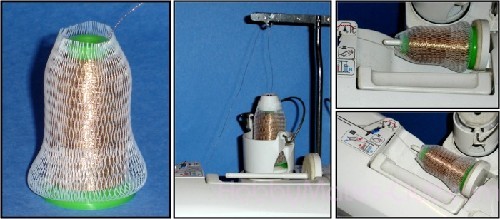
|


|
|
|
|
|
|
Home  Arts and Crafts
Arts and Crafts  Embroidery Embroidery  Tips & Hints Tips & Hints
|
|
|
|
|
|
|
|
Published: 03/24/2009 12:53PM
|
|
|
|
Here are several tips for working with metallic thread. (These rules apply to any thread brand.) We hope that they help you to get the best out of your metallic thread, because they are definitely more challenging to handle than regular embroidery thread.
If you experience any trouble with metallic thread, please try the following steps, in this order:
1. Make sure you use a quality, new, SHARP "Metallic Needle." (Metallic needles have a larger eye, which allows metallic thread to run more smoothly. Often, this eye has Teflon coating, for even better effect.)
2. If you see that the thread is coming off the spool too easily and this is causing loops and knots at the very beginning, try using a thread net (spool net). These can really help with looping issues, and they cost only pennies. Below is shown what a thread net looks like (the first photo shows a closeup of thread net on metallic thread cone, the second is a photo on cone with net in vertical position, and the last two pictures - in horizontal cone position).
|
| Most metallic thread, especially the brands that have a high sheen and really are "metallic," have looping problem. But it's an issue that is easy to solve, while the benefits of using shiny metallic thread are huge.
| |  |
Another possible solution to "early looping" problems is to use a QUALITY vertical thread stand (thread feeder), as this issue is especially noticeable on machines that have horizontally positioned spool. If you have a good thread stand, it's worthwhile to try it. It is better to use thread stand staying separately from embroidery machine as far as possible to give time to metallic thread to relax.
3. Machine speed should be reduced. Try the lowest speed you can set on your machine, and observe the results. Move the speed up, little by little, until the point where it begins to cause thread breakage. Turn the speed down a bit down from there, to the best point of good performance.
4. Make sure the top thread tension is not too high for a metallic thread. Usually, metallic thread require a lower thread tension than regular embroidery thread. Lowering the tension can also help guard against shredding.
5. Make sure that your DESIGN is suitable for metallic. Many designs are digitized in such a way that they work badly with any metallic thread. When working with metallic thread, avoid the following designs:
5.1 Many overlapping objects that create 3 and more stitch layers
5.2 Designs with many small stitches
5.3 Designs with very dense areas
6. Make sure that you're using an appropriate backing. Metallic thread usually work MUCH better with backings that have a Viscose or Cotton component in them. 100% polyester backings are usually quite sturdy, and tend to create too much friction with needle and thread. This friction can cause unwanted thread breaks. Whenever you can, use a backing with a viscose or cotton component. Soft cutaway backings usually work best with metallic thread.
7. Make sure that you're using an appropriate fabric type. Fabric that is too thick or dense can cause unwanted friction, therefore causing metallic thread breakage. When working with metallic thread, always try to use soft materials and natural fibers.
8. Some metallic thread work better if they're cooled in a freezer for several minutes before embroidering.
We hope these tips will help!
If you have more suggestions or hints on how to use embroidery metallic thread we will be glad to hear them.
|
|
|
|
|

|
|
Votes:12
|
|
Views:12817
|
|
|
|
|
|
|
|
|
|
|
|
|
See All Comments: 9
|
|
|
Hobbymates' Comments:
| | I always use a few drops of "Sewers Aid" onto the thread on the reel before I start sewing. I think it helps the thread to run more smoothly. I have never had any trouble when using metallic thread, as you suggest using the correct needle is a must.
| | some great hints here, I've all but thrown out my metallic thread. I am very new to embroidery, so I need all kinds of hints.
| | This set of tips is so good, that I signed up for hobbymates!
|
|
|
|
See Also
|
|
|
|
|
|
|
|
|



